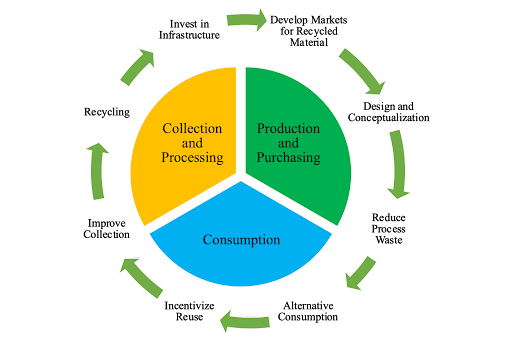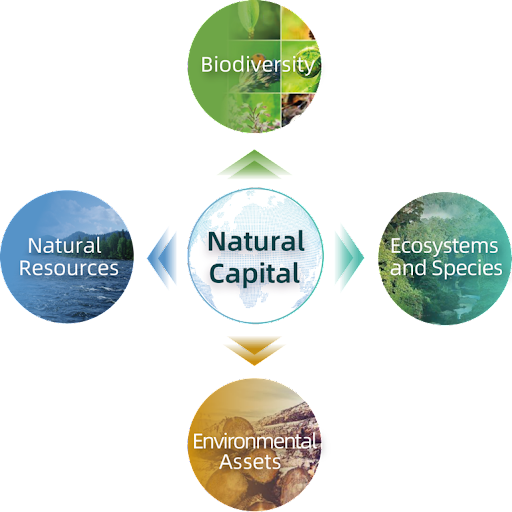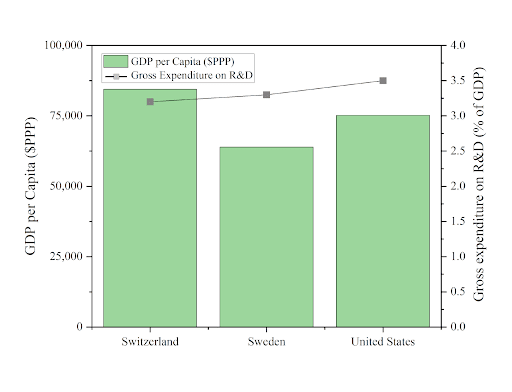Sustainable use of natural resources, respect for the planet’s biophysical limits: a holistic approach


· 13 min read
In this sense, the present extract aims to summarize the intricated web of connections that bind together the diverse aspects of sustainable resource management, illuminating the path towards a more harmonious coexistence with our planet. The chapter succinctly outlines how the promotion of resource use can be achieved through the lenses of circular economy, natural capital preservation, grassroots movements, stakeholder collaboration, societal well-being enhancement, and the widespread adoption of low-carbon energy sources.
Circular economy principles form the bedrock of a sustainable and regenerative economic model and share a symbiotic relationship with the energy transition. Conceptualizing and designing products with circularity in mind challenges industries to question the necessity of certain materials, prioritizes sustainable alternatives, and reduces the energy-intensive demands of constant production. This conservation of resources aligns with the goals of the energy transition, emphasizing a shift to renewable sources. Embracing reusable and recyclable materials becomes integral, fostering a paradigm shift away from the linear "take-make-dispose" model [2]. This approach not only diminishes the environmental footprint across the entire life cycle of a product but also catalyzes innovation that aligns with principles of reuse and regeneration. This is particularly crucial in the domain of equipment necessitating materials, like lithium and rare-earth elements, which pose environmental challenges in natural extraction. In Fig. 1, a schematic synthesizing the key components of the circular economy framework is shown.

Fig. 1: Circular Economy Framework. Adapted from: [3]
In addition, integrating circular principles accelerates the transition to cleaner energy systems, creating a holistic approach that addresses resource management and energy sustainability for a more resilient and environmentally conscious future. Nevertheless, the shift towards a circular economy requires substantial societal transformations and an elevated sense of responsibility in how we consume. It entails a fundamental change in individual behaviours, with a focus on prioritizing durability over disposability and moving away from a throwaway culture. Education emerges as a key player in this transition, serving to raise awareness about sustainable choices and the environmental repercussions of consumption. Cultivating a mindset that esteems quality, longevity, and conscious consumption becomes integral to fostering a collective shift towards sustainability. By embracing this ethos, individuals can actively contribute to the global transition to a circular economy, thereby championing a more responsible and resilient future.
Natural capital forms a foundational principle for sustainable use of materials. Preserving natural capital, which includes ecosystems, biodiversity, and natural resources, is fundamental to sustainable resource use. Natural capital accounting quantifies nature's contributions, emphasizing its economic value and societal benefits, providing a framework to understand the environmental impact of resource extraction and consumption (fig. 2). This accounting framework offers insights into the environmental impact of resource extraction and consumption, guiding efforts to align economic activities with the finite capacity of ecosystems and ensuring the well-being of future generations.

Fig. 2: Natural Capital Framework. Source: [4]
The Amazonia Forest in South America stands as a quintessential example of natural capital. Without the lens of natural capital accounting, the true significance of this region might be overlooked. Its rivers play a pivotal role in supplying water to nine countries. Simultaneously, its forests act as a crucial environmental player, absorbing carbon dioxide and releasing oxygen and moisture into the atmosphere. This process contributes significantly to the creation of rainfall, impacting weather patterns far beyond its borders [5]. The Amazon area is also characterized by unparalleled biodiversity, housing thousands of unique animal and plant species. The profound richness of the Amazonian ecosystem underscores the critical importance of preserving natural capital. Recognizing and valuing the intricate contributions of this region, from its environmental functions to its wealth of biodiversity, becomes paramount for the benefit of both present and future generations. It serves as a poignant reminder of how natural capital when properly understood and accounted for, reinforces the interconnectedness between the environment and human well-being.
They play pivotal roles that demand careful examination when contemplating the shift towards a global economy grounded in a sustainable resource-use paradigm. Local initiatives, driven by the tangible repercussions of unsustainable practices, exemplify the viability and advantages of embracing sustainable living and may contribute to the educational transformation required for the mainstream implementation of a circular economy. Notably, movements such as the European Climate Pact Ambassadors serve as outstanding illustrations. These endeavours actively contribute to enhancing consumer literacy across a spectrum of issues, ranging from energy dynamics to informed user choices. They achieve this through various channels, including organizing informative sessions featuring experts, publishing technical and opinion articles, and engaging in activism by hosting events that underscore the critical significance of climate change mitigation and drive positive change. Moreover, grassroots movements serve as a channel for amplifying the diverse voices of the general public. By incorporating individuals with distinct visions and concerns into their ranks, these movements become a robust platform for evaluating public sentiment. Within the realm of informed consumer choices, grassroots campaigns wield influence that resonates in the market, fostering a demand for eco-friendly products. This influence compels businesses to adopt responsible resource management strategies.
A concrete example of this influence is evident in the advocacy for eco-labelling, a system to identify the energy efficiency, resource conservation, waste reduction, and overall environmental impact of a product. Informed consumers, empowered by eco-labelling initiatives, actively stimulate demand for goods sourced and produced sustainably. This dynamic interaction creates a positive feedback loop, incentivizing businesses to prioritize sustainability in response to consumer preferences. In the European Union, eco-labelling is facilitated through the EU Ecolabel, which is a voluntary certification scheme designed to promote products and services with a reduced environmental impact throughout their lifecycle[6].
Stakeholder collaboration is paramount in achieving sustainable resource use. By fostering collaboration across diverse sectors, industries, supply chains, as well as forging partnerships between governments and businesses, a holistic approach emerges to grapple with the intricacies of resource management. A compelling example lies in the synergy between government and business entities, instrumental in shaping policies and regulations essential for fostering sustainable resource practices. This collaboration leverages regulatory authority alongside private sector innovation, harmonizing policy frameworks with sustainable business practices to chart a course towards a balanced future. Moreover, inter-industry collaboration assumes a pivotal role, particularly in originating innovative solutions for challenges such as waste management and the integration of low-carbon energy within the energy sector. Collaborative initiatives also extend their impact to infrastructure development, where sustainability takes centre stage.
Sustainable infrastructure endeavours to curtail resource depletion, minimize energy consumption, and incorporate eco-friendly materials. Notably, resilient infrastructure, designed to adapt to environmental changes, diminishes the necessity for frequent repairs or reconstruction, thereby mitigating resource consumption. The adoption of sustainable and resilient design principles positions infrastructure as a significant contributor to a harmonious coexistence within planetary boundaries. The imperative for stakeholder collaboration is equally pronounced at the international government level, where concerted efforts are required to facilitate agreements pivotal for advancing sustainable resource use on a global scale. The Paris Agreement, the global plan to tackle climate change and restrict global warming, serves as a compelling example of establishing targets and commitments for sustainable practices. Stakeholder collaboration becomes indispensable in collectively addressing environmental challenges and fostering the exchange of knowledge, best practices, and technological innovations. This cooperative spirit ensures a cohesive and unified global response to the multifaceted challenges associated with resource management.
Societal well-being and resource use have a complex relationship and are deeply rooted in economic history. Societal well-being represents another pillar that should be studied in the context of the planet's biophysical limits. Throughout history, heightened consumption of resources and energy has been a driving force behind technological progress and economic prosperity. As example, Fig. 3 highlights the evolution of the Chinese GDP and the country´s electrical consumption in the last two decades, showing a clear correlation between these two factors.
However, unchecked consumption has also given rise to ecological threats that jeopardize the well-being of our ecosystems. Addressing this complex relationship requires a concerted effort to decouple economic growth from resource depletion and carbon emissions. Key to this endeavour is striking a delicate balance between energy security, resource equity, and environmental conservation.
An example of the impact of resource use on societal well-being is found in the issue of energy poverty. In Portugal, for instance, approximately 20% of households face challenges in adequately heating their homes. To solve this solution, Portugal has funded household insulation, the installation of solar thermal and solar PV in households, and a reduced energy tax for low-income households [8]. This highlights the urgent need to find a harmonious coexistence, between well-being and resource use. This demands a thoughtful and strategic approach, integrating solutions that uplift the quality of life for communities while preserving the integrity of our shared environment.
Low-carbon energy, comprising renewables and nuclear sources, is intricately linked with resource utilization. In the realm of renewable energy, which derives power from easily replenished natural sources, there is a notable absence of direct impact on resource depletion. Nuclear energy, while not renewable, distinguishes itself by generating electricity without carbon emissions, and uranium, a crucial element for this type of electricity generation, is anticipated to have natural reserves lasting thousands of years. By contrast, fossil fuels rely on non-renewable resources, and recent years have highlighted the increasing complexity of exploring economically viable coal, natural gas, and oil reserves. The exploration of new fossil fuel sources is starting to extend into unique ecosystems, such as the Arctic region, posing formidable challenges in resource management, and leading to new geopolitical issues. Therefore, it is crucial to minimize as soon as possible the use of these energetic sources in the global power system.
Yet, even within the low-carbon energy group, there exists a critical reliance on resources. The development of wind farms, solar panels, and associated infrastructure, including transmission lines and electrical batteries, necessitates rare minerals. Therefore, adopting a comprehensive perspective, underscored by life cycle assessments (LCAs), is indispensable. Life cycle assessments serve as pivotal tools for comprehending and mitigating the environmental impact of low-carbon energy products. Offering a systematic approach to evaluating the ecological footprint, LCAs guide decisions that optimize resources, curtail waste, and champion eco-friendly alternatives. Recognizing the role of transparency and accountability, industries striving for sustainability find enhanced guidance through the insights derived from life cycle assessments.
Innovation stands as a cornerstone in the pursuit of sustainable resource use, offering creative solutions to overcome challenges associated with resource depletion and environmental degradation. Technological innovation introduces advancements that enable more efficient resource utilization, from renewable energy technologies to sustainable materials and circular economy practices. Innovations in business models, consumption patterns, and societal paradigms drive the transition toward a future where resource use aligns harmoniously with planetary boundaries. Within the European Union, innovation takes centre stage in the European climate policy, with more than 35% of the economic bloc's major research program—Horizon Europe—dedicated to addressing climate change. This extensive research initiative, spanning from 2021 to 2027 with a budget of €95.5 billion, is equipped with powerful instruments and innovative governance designed to instigate systemic changes. Its overarching goal is to achieve climate neutrality and facilitate an inclusive ecological and economic transition. Simultaneously, it strengthens the EU's position in science and industrial innovation, ensuring that emerging technologies, sustainable solutions, and disruptive innovations evolve into viable products with commercial potential [9]. This dual role underscores the deep connection between innovation, resource use, stakeholder involvement, and societal well-being.
On a global scale, the correlation between innovation investment and GDP evolution is evident. The Global Innovation Index of 2023 reveals that the top three countries in terms of research and development investment - Switzerland, Sweden, and the United States of America - also rank highly in GDP per capita (fig. 4) [10]. This alignment underscores the economic impact of fostering innovation, illustrating how nations investing in research and development tend to experience robust economic growth.

Fig. 4: Top 3 Investors in Innovation, The Global Innovation Index 2023. Source: [10]
Agriculture has been a major turning point in human existence, shaping the course of our development, influencing societal well-being, and catalyzing the progress of civilization. Yet, the very methods we employ to produce, cultivate, and grow our food contribute significantly to global GHG emissions, with agriculture land use, crops, and livestock accounting for nearly 20% of the total. Recognizing this environmental challenge, there is an imperative to transition toward more sustainable farming practices. This imperative becomes even more critical when we consider the current growing global populations and accelerating the material transition from fossil fuel-based products to renewable biobased products.
Key solutions include bolstering support for local agriculture, fostering farm-to-table practices, and implementing more efficient distribution systems. A striking example of this transformative approach emerges from the Netherlands. Despite its modest size, the country holds the remarkable status of being the second-largest global exporter of agricultural products and the largest meat exporter in Europe, playing a pivotal role in shaping global agricultural landscapes. Notably, the Dutch have been pioneering groundbreaking advancements in areas such as cell-cultured meat, vertical farming, innovative seed technologies, and robotics for milking and harvesting. The Netherlands has developed a Regenerative Agriculture initiative aimed at developing and showcasing how farming can simultaneously generate agricultural produce and restore nature; creating healthy ecosystems.
Beyond these notable achievements, numerous cases highlight the Netherlands' commitment to embracing precision farming techniques. This includes harnessing geothermal energy to heat greenhouses and adopting hydroponic systems, showcasing a concerted effort to optimize water usage in plant growth [11]. These innovations, designed not only to increase efficiency but also to address environmental concerns, specifically target reducing water consumption, carbon emissions, and methane emissions.
The endeavours undertaken by Dutch producers serve as a beacon of inspiration, demonstrating how a nation, regardless of its size, can lead the charge in fostering agricultural practices that harmonize with both ecological sustainability and global food security.
The journey toward sustainable resource use and planetary boundary respect encompasses interconnected principles and collaborative efforts. Governments must enact robust environmental policies, businesses need to develop sustainable production, and individuals play a vital role through informed choices for sustainable products or practices.
Resource use is critical to achieving societal well-being; thus an inclusive approach that seeks to bridge global inequalities is essential to success. The transition should be underpinned by changes in energy and agriculture ecosystems to enable sustainability across all sectors. The interconnected principles of circular economy, natural capital, informed consumer choices and international cooperation contribute to a holistic solution. Embracing innovation, collaboration, and active involvement from all stakeholders is crucial for fostering a resilient, environmentally conscious global ecosystem and respecting planetary boundaries. This narrative underscores the shared responsibility of preserving the planet's resources for current and future generations.
illuminem Voices is a democratic space presenting the thoughts and opinions of leading Sustainability & Energy writers, their opinions do not necessarily represent those of illuminem.
[1] S. G. Yalew et al., “Impacts of climate change on energy systems in global and regional scenarios,” Nature Energy 2020 5:10, vol. 5, no. 10, pp. 794–802, Aug. 2020, doi: 10.1038/s41560-020-0664-z.
[2] F. C. Schultz and S. Rhein, “A colorful bouquet of circular economy research directions: Shifting the circular economy debates from scholarly linearity to a mutual learning journey for circular applicability,” Resour Conserv Recycl, vol. 202, p. 107346, Jan. 2024, doi: 10.1016/J.RESCONREC.2023.107346.
[3] E. Jackson, “The Circular Economy: What it means for Fracking and Plastic.” Accessed: Dec. 04, 2023. [Online]. Available: https://www.fractracker.org/2019/11/the-circular-economy/
[4] Y. Bao, “Natural Capital Framework.” Shanghai Investigation, Design and Research Institute, Shanghai, China, Nov. 2023.
[5] R. Neugarten et al., “Mapping Essential Natural Capital in Amazonia,” 2015.
[6] E. C. Directorate-General for Environment, “EU Ecolabel.” Accessed: Dec. 04, 2023. [Online]. Available: https://environment.ec.europa.eu/topics/circular-economy/eu-ecolabel-home_en
[7] National Bureau of Statistics, “China Energy Statistics 2021 Edition,” Beijing, 2021.
[8] A. Horta, J. P. Gouveia, L. Schmidt, J. C. Sousa, P. Palma, and S. Simões, “Energy poverty in Portugal: Combining vulnerability mapping with household interviews,” Energy Build, vol. 203, p. 109423, Nov. 2019, doi: 10.1016/J.ENBUILD.2019.109423.
[9] E. C. Directorate-General for Research and Innovation, “Horizon Europe.” Accessed: Dec. 04, 2023. [Online]. Available: https://research-and-innovation.ec.europa.eu/funding/funding-opportunities/funding-programmes-and-open-calls/horizon-europe_en
[10] World Intellectual Property Organization, Soumitra. Editor. Dutta, Bruno. Editor. Lanvin, Lorena. Editor. Rivera León, and Sacha. Editor. Wunsch-Vincent, “Global Innovation Index 2023,” 2023. doi: https://doi.org/10.34667/tind.48228.
[11] World Economic Forum, “These Dutch tomatoes can teach the world about sustainable agriculture.” Accessed: Dec. 04, 2023. [Online]. Available: https://www.weforum.org/agenda/2019/11/netherlands-dutch-farming-agriculture-sustainable/
Gokul Shekar

Effects · Climate Change
illuminem briefings

Mitigation · Climate Change
illuminem briefings

Climate Change · Environmental Sustainability
Financial Times

Carbon Market · Public Governance
The Guardian

Agriculture · Climate Change
Euronews

Climate Change · Effects